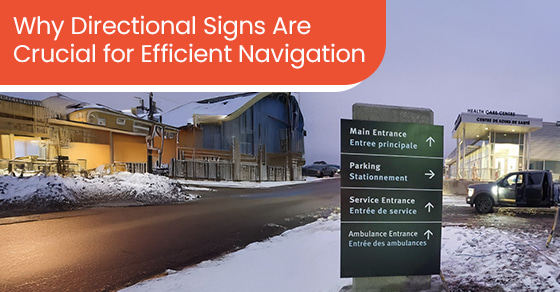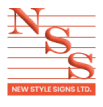
Every day, countless people step into office buildings, hospitals, shopping centres, and campuses, unsure of where to go next. Without clear guidance, frustration builds, time is wasted, and first impressions suffer. That is where directional signs make the difference. These subtle yet powerful visual tools bring order, confidence, and ease to even the most complex environments.
At New Style Signs, we know that great signage does more than point the way; it enhances how people experience your space. Our expertly designed wayfinding signage creates intuitive routes that connect people seamlessly from point A to point B. Whether you are managing a corporate facility, retail complex, or educational campus, clear facility signs make navigation effortless while reinforcing your brand’s professionalism.
Let’s explore how directional signage improves building navigation, strengthens safety, and supports better user experiences across industries.
How Directional Signs Improve Building Navigation
In any large or high-traffic space, people rely on visual guidance to move efficiently. Well-planned directional signs create a clear flow of movement, helping individuals reach their destinations with confidence. When clarity, consistency, and strategic placement come together, signage transforms complex layouts into organized and intuitive environments.
Provide Clarity in Complex Layouts
In large or unfamiliar spaces, people depend on clear cues to find their way. Quality directional signs eliminate confusion by outlining straightforward routes to key destinations. They are especially valuable in places such as hospitals, corporate offices, university campuses, and shopping centres where multiple paths and entry points can feel overwhelming.
By positioning signs at important decision points, including intersections, elevators, and corridors, visitors can move confidently. This efficiency not only saves time but also enhances the overall impression of a well-managed facility.
Enhance Safety and Emergency Response
Effective wayfinding signage is an essential part of safety planning. During an emergency, visible and properly positioned signs help occupants locate exits quickly and guide first responders to key areas.
Facilities that meet safety and accessibility standards feature consistent, easy-to-read exit markers and directional arrows. These visual guides improve response times and support compliance with safety regulations. A clear path can make a vital difference during evacuations or emergency procedures.
Improve Visitor and Customer Experience
Visitors form immediate impressions about a facility’s organization and professionalism based on how easy it is to navigate. When directional signs are clear and strategically placed, they reduce frustration and help users feel comfortable in new surroundings.
For businesses such as retail stores, hotels, and entertainment venues, this directly enhances customer satisfaction. A well-planned building navigation system can increase dwell time and build trust. Clear signage helps visitors feel in control, leading to a more positive and confident experience.
Support Staff and Operational Efficiency
Facility signs are valuable not only for visitors but also for employees. In large buildings or campuses, clear signage saves time by guiding staff to departments, meeting rooms, or service areas.
This improved efficiency reduces delays, minimizes unnecessary movement, and supports smooth operations. Maintenance crews, delivery drivers, and contractors also benefit from precise wayfinding signage that directs them exactly where they need to go. Over time, these efficiencies contribute to increased productivity and better facility management.
Reinforce Brand Identity Through Design
Directional signage provides more than guidance; it also expresses a brand’s identity. Incorporating company logos, fonts, and colours into directional signs enhances recognition and professionalism.
Cohesive design across all signs creates a polished, unified appearance that reflects a company’s attention to detail. Whether using brushed metal finishes for corporate offices or vibrant acrylic for retail spaces, the design should align with your brand image. Every wayfinding signage element is an opportunity to build trust and consistency in your visual identity.
4 Key Features of Effective Wayfinding Signage
1. Clear and Legible Typography and Icons
Easy readability is the foundation of effective signage. Choose clean, sans-serif fonts with proper spacing and ensure lettering is large enough to be read from a distance. Incorporate universally recognized symbols to help users interpret directions quickly, especially in multilingual or high-traffic settings.
Avoid decorative fonts that reduce clarity. Use high-contrast backgrounds, appropriate lighting, and minimal wording, so information can be understood at a glance. Consistent, standardized icons such as arrows, restrooms, and accessibility symbols make navigation easier for all users, including those with visual or cognitive challenges.
2. Consistent Formatting and Placement
Consistency allows users to develop a mental map of their surroundings. Maintain uniform fonts, colour schemes, and icon styles across all facility signs. Place signs at predictable heights and angles, so visitors can anticipate their locations. This consistency builds trust and reduces confusion.
When signs follow a logical order, users instinctively know where to look for the next cue. For example, maintaining the same layout and height along hallways improves orientation. Consistent formatting also supports accessibility guidelines, ensuring that all visitors, including those with visual or mobility impairments, can navigate the site with confidence.
3. Durable Materials for Long-Term Use
High-quality materials are essential for both indoor and outdoor directional signs. Durable substrates such as aluminum, acrylic, or high-pressure laminates resist wear, weather, and fading. For outdoor signs, UV-resistant coatings protect colours from sunlight, while indoor signs can use sleek finishes that complement interior design.
Longevity is key to cost-effectiveness. Choosing vandal-resistant finishes, corrosion-proof fasteners, and easy-to-clean surfaces reduces maintenance needs. In environments with moisture or temperature changes, materials like powder-coated aluminum or sealed-edge acrylic offer the best performance. Durable materials keep signage attractive and functional for years.
4. Strategic Use of Colour and Contrast
Colour can significantly determine the effectiveness of wayfinding signage. High-contrast combinations improve visibility and ensure readability in all lighting conditions. Consistent colour schemes also help users identify sign types quickly, such as blue for information, green for directions, and red for exits.
Colour psychology can further enhance usability. Warm tones, such as red and yellow, attract attention to urgent information, while cooler tones, like blue and green, create a sense of calm and direction. Always ensure text and background colours meet accessibility standards. Thoughtful colour use improves both visual appeal and functionality across your building navigation system.
Applications of Directional Signs in Different Industries
Directional signs are essential across all industries, from healthcare to retail. Every environment presents unique navigation challenges, and effective wayfinding signage must adapt to meet them. Whether guiding patients to treatment areas or helping shoppers locate their favourite stores, the right facility signs make movement simple, safe, and stress-free.
- Healthcare: Hospitals and clinics depend on directional signs to guide patients and visitors through complex layouts that include waiting rooms, treatment areas, and departments. Clearly labelled pathways help reduce stress and allow quick access to critical areas such as emergency rooms and exits. Consistent wayfinding signage also supports accessibility and assists first responders in emergencies.
- Education: Schools, colleges, and universities benefit from organized wayfinding signage that simplifies navigation for students, faculty, and visitors. Clear signs reduce confusion on large campuses, directing people to classrooms, libraries, administrative offices, and residences. Colour-coded facility signs can also identify different departments or zones, improving orientation and overall campus flow.
- Retail: Shopping centres and large stores use facility signs to manage customer flow and improve the shopping experience. Directional signs help visitors locate stores, amenities, and restrooms while encouraging exploration. Strategic wayfinding signage placement improves traffic flow during busy times and highlights promotions or key areas, increasing satisfaction and potential sales.
- Corporate: Office buildings and business parks rely on branded wayfinding signage to maintain professionalism and efficiency. Clear, uniform signs help employees and visitors find meeting rooms, reception areas, and departments quickly. Including brand colours, materials, and logos reinforces identity while combining functionality with polished design.
Across all industries, well-designed directional signs improve user experience, enhance safety, and promote smooth movement through every environment.
Make Navigation Seamless With Directional Signage Solutions
A well-designed directional sign does more than guide movement; it shapes how people experience your environment. The right signage enhances safety, strengthens your brand, and ensures every visitor feels confident from the moment they enter.
At New Style Signs, we bring decades of expertise, precision craftsmanship, and design innovation to every project. Our team understands how to create wayfinding signage that performs beautifully and aligns seamlessly with your facility’s structure and purpose. Whether you need facility signs for a corporate complex or a custom building navigation system for a healthcare or retail space, we deliver solutions that are both functional and visually refined.
We don’t only make signs. We create visual systems that connect people to spaces. Every sign is designed with clarity, durability, and long-term performance in mind, ensuring your investment stands the test of time.
Discover how New Style Signs can redefine how people move through your property. To learn more about our directional signs, call New Style Signs today at 866-591-6938 or contact us here.
FAQ
What are directional signs used for?
They guide people to specific locations within a building or facility, helping with navigation and wayfinding signage.
Where should directional signs be placed?
Signs should be positioned at decision points such as entrances, hallways, intersections, and elevator banks to support smooth building navigation.
Can directional signs be customized with branding?
Yes. Effective directional signs often include company logos, colours, and fonts to reinforce branding and visual identity.
Are directional signs required by building codes?
In many cases, especially for accessibility and emergency exits, facility signs must meet local regulations for compliance.
How do directional signs differ from informational signs?
Directional signs guide movement through a space, while informational signs provide general details, instructions, or policies.





Leave A Comment